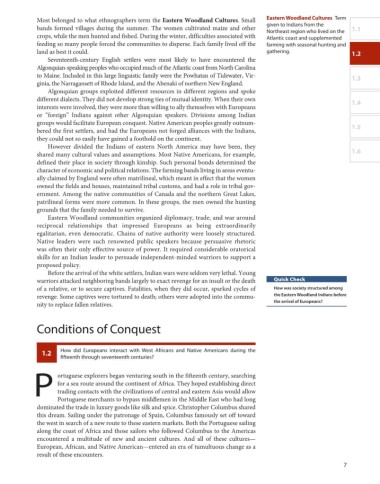Page 40 - American Stories, A History of the United States
P. 40
Most belonged to what ethnographers term the Eastern Woodland Cultures. Small Eastern woodland Cultures Term
bands formed villages during the summer. The women cultivated maize and other given to Indians from the 1.1
Northeast region who lived on the
crops, while the men hunted and fished. During the winter, difficulties associated with Atlantic coast and supplemented
feeding so many people forced the communities to disperse. Each family lived off the farming with seasonal hunting and
land as best it could. gathering. 1.2
Seventeenth-century English settlers were most likely to have encountered the
Algonquian-speaking peoples who occupied much of the Atlantic coast from North Carolina
to Maine. Included in this large linguistic family were the Powhatan of Tidewater, Vir- 1.3
ginia, the Narragansett of Rhode Island, and the Abenaki of northern New England.
Algonquian groups exploited different resources in different regions and spoke
different dialects. They did not develop strong ties of mutual identity. When their own 1.4
interests were involved, they were more than willing to ally themselves with Europeans
or “foreign” Indians against other Algonquian speakers. Divisions among Indian
groups would facilitate European conquest. Native American peoples greatly outnum-
bered the first settlers, and had the Europeans not forged alliances with the Indians, 1.5
they could not so easily have gained a foothold on the continent.
However divided the Indians of eastern North America may have been, they
shared many cultural values and assumptions. Most Native Americans, for example, 1.6
defined their place in society through kinship. Such personal bonds determined the
character of economic and political relations. The farming bands living in areas eventu-
ally claimed by England were often matrilineal, which meant in effect that the women
owned the fields and houses, maintained tribal customs, and had a role in tribal gov-
ernment. Among the native communities of Canada and the northern Great Lakes,
patrilineal forms were more common. In these groups, the men owned the hunting
grounds that the family needed to survive.
Eastern Woodland communities organized diplomacy, trade, and war around
reciprocal relationships that impressed Europeans as being extraordinarily
egalitarian, even democratic. Chains of native authority were loosely structured.
Native leaders were such renowned public speakers because persuasive rhetoric
was often their only effective source of power. It required considerable oratorical
skills for an Indian leader to persuade independent-minded warriors to support a
proposed policy.
Before the arrival of the white settlers, Indian wars were seldom very lethal. Young
warriors attacked neighboring bands largely to exact revenge for an insult or the death Quick Check
of a relative, or to secure captives. Fatalities, when they did occur, sparked cycles of How was society structured among
revenge. Some captives were tortured to death; others were adopted into the commu- the Eastern Woodland Indians before
nity to replace fallen relatives. the arrival of Europeans?
Conditions of Conquest
1.2 How did Europeans interact with West Africans and Native Americans during the
fifteenth through seventeenth centuries?
P ortuguese explorers began venturing south in the fifteenth century, searching
for a sea route around the continent of Africa. They hoped establishing direct
trading contacts with the civilizations of central and eastern Asia would allow
Portuguese merchants to bypass middlemen in the Middle East who had long
dominated the trade in luxury goods like silk and spice. Christopher Columbus shared
this dream. Sailing under the patronage of Spain, Columbus famously set off toward
the west in search of a new route to these eastern markets. Both the Portuguese sailing
along the coast of Africa and those sailors who followed Columbus to the Americas
encountered a multitude of new and ancient cultures. And all of these cultures—
European, African, and Native American—entered an era of tumultuous change as a
result of these encounters.
7

